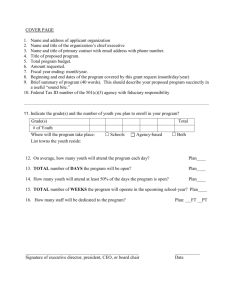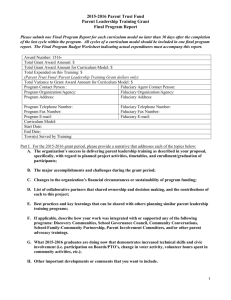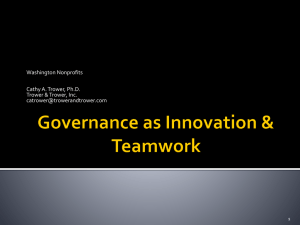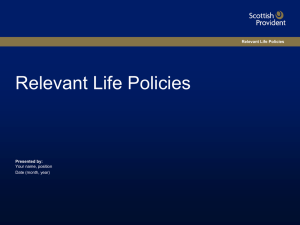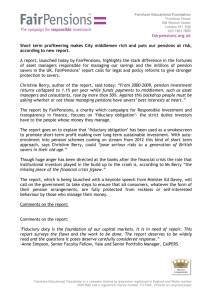Tue 11.15 Union Fiduciary
advertisement
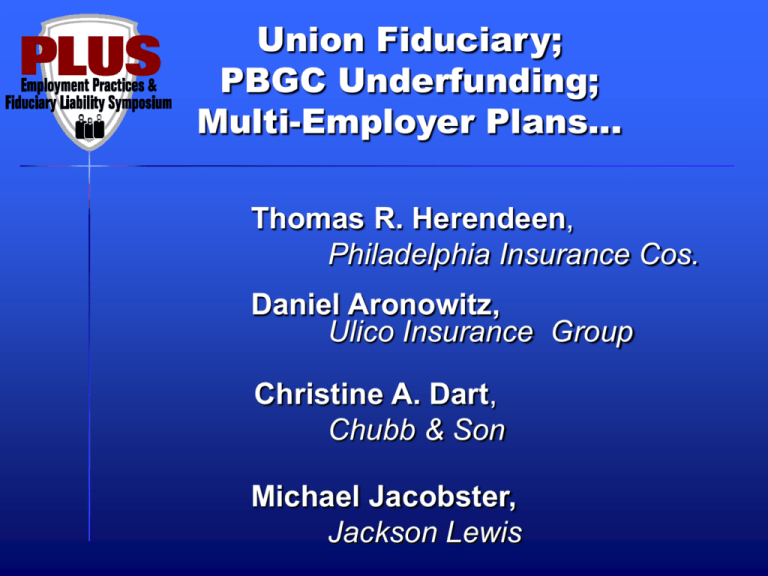
Union Fiduciary; PBGC Underfunding; Multi-Employer Plans… Thomas R. Herendeen, Philadelphia Insurance Cos. Daniel Aronowitz, Ulico Insurance Group Christine A. Dart, Chubb & Son Michael Jacobster, Jackson Lewis Session Objectives • Explain the unique underwriting issues associated with providing fiduciary liability insurance to multi-employer plans • Identify key legal issues that take on greater significance for multi-employer plan trustees • Review significant claims and highlight trends “Multi-Employers” Who Are They? • Labor Unions – Taft/Hartley – joint management/labor sponsorship • Trade Associations – Multiple Employer Trust – group of similar employers • Voluntary Employee Benefit Association (VEBA) – loose/no connection between the participants Union Demographics • 16.1 Million workers in the U.S. are represented by a labor union • 9 Million are represented by unions within the AFL-CIO • There are 54 trades represented by the AFL-CIO including a range of private and public sector employees Union Characteristics • Heightened Fiduciary Responsibility • Greater scrutiny by outside parties – DOL, members, employers • Increased potential for conflicts of interest – political pressure, economic clout, vendor selection, etc. Multi-Employer Plans panelists • Christine Dart, Vice President, Chubb Specialty Insurance • Michael Jacobster, General Partner, Jackson Lewis LLP • Daniel Aronowitz, President, Ulico Insurance Group The Underwriter’s Perspective Christine Dart, Vice President, Product Manager Chubb Specialty Insurance Multi-Employer Trust Underwriting Review Financial Stability • Industry represented and potential for future growth • Growth in plan assets and participants • Percentage of active/total participant ratio • Funding position of the plan • Increase in withdrawal liability claims Multi-Employer Trust Underwriting Review Types of Trusts • Pension • Welfare Plan Vacation Training Health/Medical/Dental • Review all service providers Multi-Employer Trust Underwriting Review Medical Plans • Self-funded • Self-administered • Adequate reserves to cover future medical expenses • Stop-loss insurance available • Administrative expenses appear in line • Retiree medical benefits Multi-Employer Trust Underwriting Review Diversification of Plan Assets • Be aware of social investing • Partnerships • Loans • Real Estate Does the trust use a Qualified Professional Asset Manager (QPAM) to oversee & implement the real estate investment strategy? Do Trustees review the QPAM for potential conflicts of interest? Multi-Employer Trust Underwriting Review Documentation and Oversight Are Trustee meetings regularly scheduled and documented? Where there is a delegation of fiduciary duties, do the Trustees document the qualification and backgrounds of the candidates? Does the plan keep a written acknowledgement of the investment manager’s fiduciary status for its official records? Are investment objectives documented, including why particular options were chosen? Are strategies established on an annual basis to meet the investment objectives of the plan? Is there an active and comprehensive monitoring program to evaluate the performance of appointees, especially in the areas of administrative and investment management responsibilities? Are investment management and advisory agreements carefully reviewed for conflicts with the plans guidelines or goals? Multi-Employer Trust Underwriting Review Documentation and Oversight Trustee meetings Delegation of fiduciary duties Written acknowledgement of fiduciary status Investment objectives documented Strategies are established on an annual basis Active and comprehensive monitoring program to evaluate the performance Investment management and advisory agreements reviewed for conflicts Legal Environment Michael Jacobster General Partner, Jackson Lewis LLP M-E Plans Legal Environment • ERISA Definition and Overview Fiduciary rules Withdrawal liability rules • Taft-Hartley Act Structural requirements Deadlock issues M-E PLANS Fiduciary Legal Issues • Fiduciary Duties Exclusive Benefit Rule Prudence Rule • “Appropriate consideration”/Procedural Diversification Requirement Plan Document Requirement M-E Plans Structural Liability Issues • Settlor functions – benefit structure claims Non-fiduciary in single employer (“SE”) plan world • In M-E world – distinction sometimes blurred Pre- and post-Schoonejongen and Spink decisions • Converts benefits claim into fiduciary suit M-E Plan Specific Problems • Conflicts of Interest Not a bargaining representative – duty solely to participants • Contribution Collection Issues • Social Investing Pressures/Job Creation Pressures • Disclosure to Other Fiduciaries – When recusal not enough • “Laissez-faire” and sleeping fiduciaries M-E Plans Basic Due Diligence • Document Retention Program-Benefit Claims Issues • Investment Guidelines • Investment Decision Process Records • Investment Review Procedures • Vendor Contracts • Vendor Performance Review • Compliance Audit Issues Claims Issues and Trends Daniel Aronowitz President, Ulico Insurance Group Multi-Employer Plans • Claims – Typical Allegations Most Severe Payouts Loss Trends in Recent Years Examples Multi-Employer Plan Claims • Overview of Claim Trends • Most Severe Payouts – Capital Consultants and Diplomat Hotel • Loss Trends • Claim Examples Claim Examples 1. 2. 3. 4. 5. 6. 7. 8. 9. 10. Imprudent Investment Claims Real Estate Claims Withdrawal Liability Claims Benefit Claims Funding Claims Administrative Expense Claims DOL Voluntary Fiduciary Correction Program Settlor Claims Prohibited Transaction Claims Dishonesty Claims 1. Imprudent Investment Claims • Trustees of Pension Plan invested $750,000 for 825 units in the Aspen By Pulp Mill Project to be built in Upper Peninsula of Michigan. • DOL filed suit alleging that the Trustees breached their fiduciary duties (failure to act solely in the interest of beneficiaries and for the exclusive purpose of providing benefits and ignoring Fund Counsel’s advice). • Plumbers and Pipefitters (UA) – Diplomat Hotel (invested $800 million – 27% below $587 mil project value). 2. Real Estate Investments • Coffee Creek – DOL and participants allege that the Northwest Indiana District Council of Carpenters breached fiduciary duties for investing $10 million of pension fund assets in a 640-acre residential and commercial land development on Lake Erie. • Somerset Ridge – DOL lawsuit alleging investment advisor imprudently invested without appraisal and proper investigation $10 mil of Laborer pension fund assets in 120-acre tract of raw land in N. Las Vegas. • Mason Tenders District Council of NY – trustees of pension fund found to have breached fiduciary duties in purchasing NY office building without appraisal for $24 mil ($16.5 mil higher than sale 10 months earlier) and without QPAM. 3. Withdrawal Liability • Withdrawal Liability – when benefit fund asks the employer to pay unfunded liability • Typical claim alleges that (a) employer(s) told the plan is financially ok; (b) a recent increase in unfunded benefits; and (c) significant investment losses • Brach’s Confections Inc./Central States Southeast and Southwest Pension Fund – Brach’s assessed $31 mil in withdrawal liability after it closed facility covered by CBA. 4. Benefit Claims • Pension Fund (a) miscalculated pension benefits, or (b) improperly suspended benefits. • Health and Welfare Fund wrongfully denied medical treatment or expenses • Pension Fund: (a) Trustees failed to collect employer contributions; or (b) trustees increased Plan benefits without increasing employer contributions. • Health and Welfare Fund: (a) financial condition deteriorated to crisis position; (b) major “incurred” and “incurred but not reported” liabilities outstanding. 5. Funding/Reserve Claim • Financial distress due to rising health care costs and greater utilization • Trustees only partially implemented repeated consultant’s recommended rate increases • Exhaustion of Plan reserves • Forced withholding of claim payments. • Trustees' actions suggested a willingness to allow the Plan reserves to shrink in order to maintain low rates for contributing employers instead of maintaining reserves for their intended purpose • Failure to provide adequate funding and maintain sufficient reserves for the Plan violated ERISA’s prudent man standard of care (section 404(a)(1)(B)). 6. Administrative Expense Claims • Growing category of DOL claims • Alleged breaches of fiduciary duty for improper payment of collection services, improper allocation of payroll audit fees, improper expenses for office workers shared with the union and legal fees. 7. DOL Voluntary Fiduciary Correction Program Fiduciary breaches that are eligible for correction under the VFC program: ● Late Payment of participant contributions to benefit plans; ● Loans to or from parties-in-interest, either at or below market interest rates; ● Purchase or sale of assets between a plan and a party in interest; ● Sale and leaseback of property to a sponsoring employer; ● Purchase or sale of assets between a plan and an unrelated party, at below-market value; ● Under- or over-payment of benefits due to inaccurate valuation of plan assets; ● Payment of duplicative, excessive or unnecessary compensation to a party in interest; and ● Payment of dual compensation to a fiduciary. 8. Settlor Claims • Settlor Functions – lie outside the fiduciary requirements of ERISA • Involve plan design – creation, modification or termination • But are they covered under a fiduciary liability policy? LaFata v. Cement Workers example of plan amendments. 9. Prohibited Transactions Claims • Most common is the failure to collect contributions • Using plan assets to advance union interests • Payment of compensation to trustees for “services” allegedly rendered • Transfers of assets between related plans (to prop up financially troubled plans) • Use of plan assets to benefit friends and families of union officers and companies owned by Trustees • Kickbacks and other improper payments to pay trustees – ex., Capital Consultants hunting and fishing trips 10. Fraud/Dishonesty Claims • Teamsters Union 25 Health Services & Insurance Plan – two trustees of the Plan were indicted and pled guilty to theft and embezzlement from the pension plan; false statements made in ERISA plan documents; mail fraud. • U.S. v. International Longshoremen’s Assoc., et al. (E.D.N.Y.) – DOJ alleges that the ILA Fund Trustees “rigged” the awarding of its pharmacy benefit manager and mental health benefits contracts (choosing a less desirable vendor because of ties to the contractor and organized crime). Sample Claim 1: Withdrawal Liability Claim • Withdrawal Liability – when benefit fund asks the employer to pay unfunded liability • Assumed facts: (a) employer(s) told the plan is financially ok; (b) a recent increase in unfunded benefits; and (c) significant investment losses Withdrawal Liability Coverage Issues • Was there a potential breach of fiduciary duty? • Does telling the employer(s) everything is OK improve or hurt coverage? • Does the increase in benefits and investment losses affect coverage? • What scope of coverage might be provided? • What happens if arbitration is invoked by either party? Sample Claim 2: Benefit Claims • Assumed facts: Pension Fund (a) miscalculated pension benefits, or (b) improperly suspended benefits. Health and Welfare Fund wrongfully denied medical treatment or expenses Sample Claim 3: Funding Claims • Pension Fund: (a) Trustees failed to collect employer contributions; or (b) trustees increased Plan benefits without increasing employer contributions. • Health and Welfare Fund: (a) financial condition deteriorated to crisis position; (b) major “incurred” and “incurred but not reported” liabilities outstanding • Are employer contributions a fiduciary exposure? • Do benefit improvements without increased employer contributions increase risk? • What is the risk of deteriorating financial condition in an H&W or Pension Plan? Sample DOL Funding/Reserve Claim • Financial distress due to rising health care costs and greater utilization • Trustees only partially implemented repeated consultant’s recommended rate increases • Exhaustion of Plan reserves • Forced withholding of claim payments. • Trustees' actions suggested a willingness to allow the Plan reserves to shrink in order to maintain low rates for contributing employers instead of maintaining reserves for their intended purpose • Failure to provide adequate funding and maintain sufficient reserves for the Plan violated ERISA’s prudent man standard of care (section 404(a)(1)(B)). Sample Claim 4: DOL Voluntary Fiduciary Correction Program • Payment of benefits without properly valuing plan assets on which payment is based. • DOL Description of Transaction: “A defined contribution pension plan pays benefits based on the value of the plan’s assets. If one or more of the plan’s assets are not valued at the current value, the benefit payments are not correct. If the plan’s assets are overvalued, the current benefit payments will be too high. If the plan’s assets are undervalued, the current benefit payments will be too low.” Sample Claim 5: Settlor Claims • Settlor Functions – lie outside the fiduciary requirements of ERISA • Involve plan design – creation, modification or termination • But are they covered under a fiduciary liability policy – LaFata v. Cement Workers example Sample Claim 6: Prohibited Transactions Claims • Skeleton employees to secure pension or H&W benefits • “Trustee-directed” real estate investments • Capital Consultants Claims Sample Claim 7: Fraudulent Transaction Claims • Security transaction brokerage commission kickbacks • Other fraudulent claim examples


